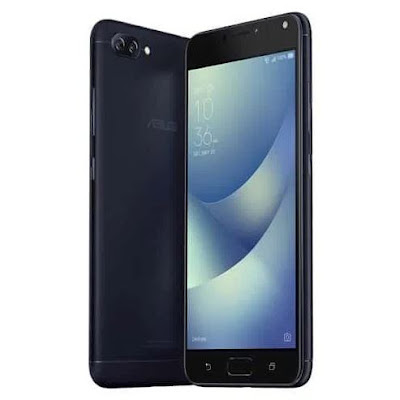 |
| Asus Zenfone 4 MAX | Smartphone Evolution |
The design of the ZenFone 4 Max is similar to its brother ZenFone Max Pro. The most striking comparison is the smaller size. The screen protrudes slightly from the curved body of the phone so it looks a little strange. In the hand, the cellphone is quite safe to hold.
The variant of the ZenFone 4 Max phone that I use is the Deepsea Black pattern. This Deepsea Black hue is more blue black than dark. Combined with an aluminum body, the phone doesn't look like a cheap one.
On the front of the cellphone there is a capacitive navigation button and a home button as well as a fingerprint scanner which is quite fast in the scanning process. There is also a front camera, speakers, and a fairly large yellow patterned flash. For me, this front flash component distracts the phone design a bit with its dark complexion.
For the back of the cellphone, there is the ASUS logo, dual rear cameras, flash, and antenna lines. The right side of the phone is a volume control and the power button. At the top there is an earphone jack and on the bottom side there is a speaker grill and a Micro USB charge slot.
The screen of the Zenfone 4 Max is quite bright and still easy to see under sunlight. But the screen resolution is a bit low at 720 x 1280 pixels, so the interface on the main cellphone application icon looks a bit aggressive. For phones in this price class, I'm quite satisfied with the quality of the resulting screen display.
In terms of performance, for universal use such as navigating the cellphone, changing applications, typing emails, and others, the performance presented has been ok. However, some times I find that when I change the application there is a slight delay and the popup that appears when massaging the built-in virtual keyboard feels less responsive.
When you try to play a game like Mobile Legends, the game can be played easily even though it looks a little less smooth in terms of appearance or performance. To support performance in playing games, ASUS embeds a speed booster button when playing games to help improve performance.
For everyday use, I like surfing the website, using social networking applications like Facebook and Twitter, and writing emails, the cellphone can last for 2 full days in a normal battery mode.
The screen on time that I have is 5 hours 56 minutes as long as I use the cellphone from 100% battery energy to 16%. True to its name, ZenFone 4 Max delivers an impressive phone-resistant energy. With this kind of resistant energy, users don't need to bother charging their cellphones during activities.
The large battery capacity of the ZenFone 4 Max definitely affects the battery life of this phone. Moreover, this cellphone can be used to charge other features with the reverse charging feature. But for me it's not just an emergency, it's better to charge other features using a power bank.
For battery charging, ASUS says that this phone supports charging flash energy. When I tested it, the cellphone took 2 hours 6 minutes to charge the battery from a level of 14% to 100% using the default charger from the cellphone.
On the camera side, even though this phone focuses more on the battery, ASUS has embedded an interesting feature with its dual rear camera. One of the reverse cameras acts like a normal camera on the other hand, the other is a camera with a wide-angle lens.
For its soft features, ZenFone 4 Max currently uses Android type 7.1.1 and plans to get Android O in the near future which is the latest type of Android. As well as the usual sort, ASUS embed the ZenUI interface on their cellphones.
For those who actively use 2 SIM cards and always want to increase the capacity of their cellphones with a microSD card, ASUS provides 3 slots for 2 SIM cards and 1 microSD card. With this the user does not need to bet on one of them.
What is somewhat unfortunate about this phone is the absence of NFC. The NFC feature is indeed not often found on ASUS cellphones released in the World. Meanwhile, currently NFC technology continues to be useful as digital money continues to advance in the World. If the NFC feature is provided, this phone would be an even more attractive option for those who are more concerned with productivity on their cell phones.
Conclusion
If you often use cell phones to carry out productivity activities without worrying about the flash battery running out, this phone is right for you. ASUS ZenFone 4 max is a budget phone with a long battery life and sufficient performance.
Advantages
- Battery life energy is satisfactory
- There is a wide angle lens camera
Deficiency
- Not Full HD screen resolution
- There is no NFC



0 Comments